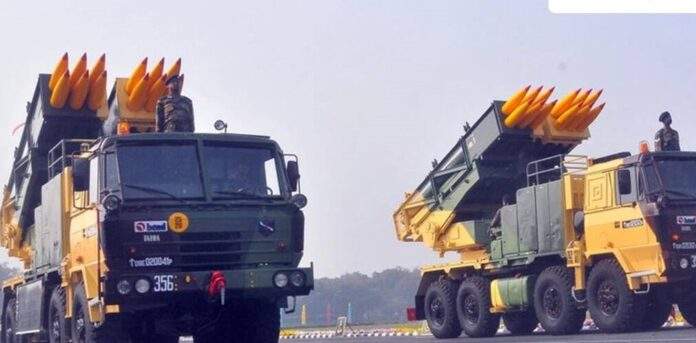DRDO (Defence Research Development Organisation) on Saturday announced that it has successfully tested the extended range Pinaka multi-barrel rocket launching system at Rajasthan’s Pokhran Range.
The system is designed by DRDO Laboratory ARDE along with HEMRL, Pune, the technology has been transferred to the Indian industry.
The Pinaka – ER is the upgraded version of the earlier version of Pinaka which has been in service with the Indian Army for the last decade. The system has been designed in the light of emerging requirements with advanced technologies enhancing the range.
Pinaka Rocket System: A look at the indigenously developed rocket system named after Lord Shiva’s bow, its role in the battlefield and importance of the latest acquisition.
The origin of Pinaka rocket system
In the battlefield, long range artillery systems like Pinaka are used for attacking the adversary targets prior to the close quarter battles which involve smaller range artillery, armoured elements and the infantry.
he development of the Pinaka was started by the Defence Research and Development Organisation (DRDO) in the late 1980s, as an alternative to the multi-barrel rocket launching systems of Russian make, called like the ‘Grad’, which are still in use.
After successful tests of Pinaka Mark-1 in the late 1990, it was first used in the battlefield during the Kargil War of 1999, quite successfully. Subsequently multiple regiments of the system came up over the 2000s.
The salvo of Pinaka, its versions and capabilities
The Pinaka, which is primarily a multi-barrel rocket system (MBRL) system, can fire a salvo of 12 rockets over a period of 44 seconds. One battery of Pinaka system consists of six launch vehicles, accompanied by the loader systems, radar and links with network based systems and a command post. One battery can neutralise an area one kilometre by one kilometre. As a key tactic of long range artillery battle, the launchers have to ‘shoot and scoot’ to ensure they themselves do not become the targets, especially due to its back blast. Thus the launcher vehicles are required to have a high degree of maneuverability.
The Mark-I version of Pinaka has a range of around 40 kilometres and the Mark-II version can fire up to 75 kilometres. Over late 2010s, multiple successful tests of the Mark-II version have been carried out by the DRDO latest ones taking place this month at Pokhran.
The Mark-II version of the rocket has been modified as a guided missile system by integrating it with the navigation, control and guidance system to improve the end accuracy and increase the range. The navigation system of the missile is linked with the Indian Regional Navigation Satellite System. In comparison to artillery guns, rockets are less accurate, but with addition of guidance and navigation systems, this aspect is taken care of.
With its upgrades, the Pinaka Mark-II can be a key element in the “network centric warfare”. The rocket system can operate various modes and can carry different types of warheads.
Note:- Article is taken from the source available on internet and doesn’t disclose any secret of our Defence Forces.










